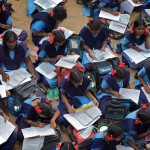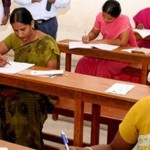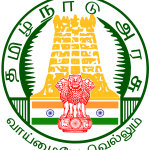
1. In the Indian Federalism, residuary powers are with
A) State Governments
B) Central Government
C) Both Central and state Government
D) Local Government
Explanation : Ans : (B)
Federalism :
The founding father of Indian constitution opted for a federal government characterised by the existence of two governments – one at the centre and one at the state. The power and authority is divided between the two by the constitution based on administrative convenience. Both are mutually exclusive yet interdependent. The division of power is based on three lists – the Union list, State list and Concurrent list. The union government enjoys authority over 97 subjects such as defence, science & technology, home, atomic energy, etc.
And the state governments enjoy
power over 66 subjects such as education, health, family planning etc. and both
the union and the states share the power over 47 subjects such as marriage,
divorce, contract based on mutual consent and consultation. Unity in diversity
is the key theme of Indian Federalism. Yet the Indian Constitution
is not wholly federal in structure because the residuary powers are vested with
the union by the states, the centre has the authority to supercede a state
government. Also, the powers vested in the president to withdraw
to the union, executive and legislative powers of a state, at any time, if the
administration of a state is not properly carried out
(Article 356). Because of this dual nature, K. C. Wheare regards Indian
constitution as partly federal and partly unitary (‘Quasi-federal’).
Alexandrowiez also considers it as “a combination of both”.
2. Mudra Bank is related to
A) Housing finance B) Micro finance
C) personal loan D) vehicle loan
Explanation : Ans : (B)
Mudra Bank : Prime Minister Narendra Modi launched the Micro Units Development and Refinance Agency Ltd. (MUDRA) Bank on 8th April 2015 to fund the small business persons. The Bank was launched under the ambitious Pradhan Mantri Jan Dhan Yojana (PMJDY). The bank will provide credit of upto ` 10 lakhs to small entrepreneurs and act as a regulator for Micro-Finance Institutions (MFIs).
The bank would be responsible for refinancing and developing all Micro-Finance Institutions (MFIs) which are in the business of giving loan to micro / small business entities engaged in service activities, trading and manufacturing.
The role of MUDRA Bank
Building a good architecture of Last Mile Credit Delivery to micro businesses
Assign policy guidelines for micro enterprise financing business
Registration of MFI entities
Maintain promotional & development activities in the sector
Accreditation/rating of MFI entities
Establish responsible financing practices to ward off over indebtedness and ensure proper client protection principles and methods of recovery
Standardised set of covenants governing last mile lending to micro enterprises should be expanded
Encouraging right technology solutions for the last mile
A Credit Guarantee Scheme for providing guarantees to the loans/portfolios which are being extended to micro enterprises should be formulated.
3. Khetri Singhana area is famous for which mineral ?
A) Iron-ore B) Bauxite
C) Coal D) Copper
Explanation : Ans : (D)
Iron ore is the basic mineral and the backbone of industrial development. India is rich in good quality iron ores. Magnetite is the finest iron ore with a very high content of iron up to 70 per cent. It has excellent magnetic qualities, especially valuable in the electrical industry. Hematite ore is the most important industrial iron ore in terms of the quantity used with 50–60 per cent iron content. The major iron ore belts in India are : Odisha – Jharkhand belt, Durg–Bastar-Chandrapur belt lies in Chattisgarh and Maharashtra. Ballari-Chitradurga–Chikkamagaluru–Tumakuru belt in Karnataka and Maharashtra–Goa belt.
Copper : Being malleable, ductile and a good conductor, copper is mainly used in electrical cables, electronics and chemical industries. The Balaghat mines in Madhya Pradesh, Khetri mines in Rajasthan and Singhbhum district of Jharkhand are leading producers of copper.
Bauxite : Though, several ores contain aluminium, it is from bauxite, a clay-like substance that alumina and later aluminium is obtained. Bauxite deposits are formed by the decomposition of a wide variety of rocks rich in aluminium silicates.
Coal : In India, coal is the most abundantly available fossil fuel. It provides a substantial part of the nation’s energy needs. It is used for power generation, to supply energy to industry as well as for domestic needs. Coal is formed due the compression of plant material over millions of years. Coal, therefore, is found in a variety of forms depending on the degrees of compression and the depth and time of burial. Decaying plants in swamps produce peat, which has a low carbon and high moisture contents and low heating capacity.
Lignite is a low grade brown coal, which is soft with high moisture content. The principal lignite reserves are in Neyveli in Tamil Nadu and are used for generation of electricity. Bituminous coal is the most popular coal in commercial use. Metallurgical coal is high grade bituminous coal which has a special value for smelting iron in blast furnaces. Anthracite is the highest quality hard coal.
In India coal occurs in rock series namely Gondwana and tertiary deposits. The major resources of Gondwana coal, which are metallurgical coal, are located in Damodar valley (West Bengal-Jharkhand).
Jharia, Raniganj, Bokaro are important coalfields. The Godavari, Mahanadi, Son and Wardha valleys also contain coal deposits. Tertiary coals occur in the north eastern states of Meghalaya, Assam, Arunachal Pradesh and Nagaland. Heavy industries and thermal power stations are located on or near the coalfields.
4. The average length of human pregnancy is
A) 34 – 36 weeks B) 36 – 38 weeks
C) 38 – 40 weeks D) 34 – 40 weeks
Explanation : Ans : (B)
The average duration of human pregnancy is about 9 months or 36-38 weeks which is called the gestation period.
5. The ‘Bondi’ bond introduced by the world bank in August 2018 is named after a popular beach in
A) USA B) Australia
C) Brazil D) Canada
Explanation : Ans : (B)
Bondi bond : The World Bank launched world’s first public block chain bond named ‘bond-i’ created, allocated, transferred and managed by using block chain technology. Bond-i is an acronym standing for Blockchain Offered New Debt Instrument and also refers to tourist famous Bondi Beach in Sydney, Australia. Funds raised from this bond will go towards sustainable development initiatives.
ÐÐÐ





